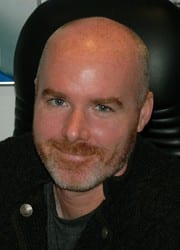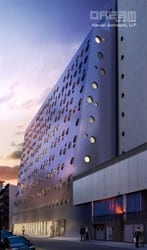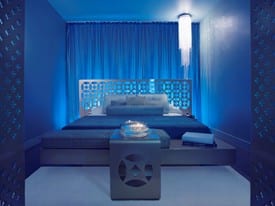Dream Believer
A Q&A with Brendan McNamara
By Stacy Shoemaker Rauen; Dream South Beach photography by David Durback
 If you haven’t heard of Brendan McNamara and the company where he serves as VP of brand development-Hampshire Hotels & Resorts, the parent company that oversees Vikram Chatwal Hotels-you are about to. Earlier this year, the hotel group entered an agreement with Wyndham to franchise and manage its Dream and Night brands globally. Dream hotels are currently in Midtown New York, Bangkok, and Cochin, India, and this summer, properties in South Beach and Downtown New York are set to make their debut, the latter of which he calls a game-changer for the brand. Besides the Midtown location of Night, another is set for Manhattan’s NoHo area next year. But that is just the beginning: McNamara predicts that 40-50 Dream and Night properties will come online in the next 10 years. Here he opens up about neuro-gastronomy, a light-only wake-up call, and creating the human fish tank.
If you haven’t heard of Brendan McNamara and the company where he serves as VP of brand development-Hampshire Hotels & Resorts, the parent company that oversees Vikram Chatwal Hotels-you are about to. Earlier this year, the hotel group entered an agreement with Wyndham to franchise and manage its Dream and Night brands globally. Dream hotels are currently in Midtown New York, Bangkok, and Cochin, India, and this summer, properties in South Beach and Downtown New York are set to make their debut, the latter of which he calls a game-changer for the brand. Besides the Midtown location of Night, another is set for Manhattan’s NoHo area next year. But that is just the beginning: McNamara predicts that 40-50 Dream and Night properties will come online in the next 10 years. Here he opens up about neuro-gastronomy, a light-only wake-up call, and creating the human fish tank.
HD: Why is it the right time to expand the Dream brand?
BM: If you look at the lifestyle segment, it is bifurcating: you have the normative sort of boutiques that are independent and then there are the branded boutiques. We have flipped from one track to the other. From being an independent group to now having this fantastic allegiance with Wyndham to expand the brand. I think anyone would tell you having a very strong reservation system with a global reach is crucial for expansion. It feels like the right time for the brand, too. We have been looking at the marketplace for a long time, and it seemed like there was a big hole where two things were meeting: lifestyle and people’s pocketbooks. If you look at how things have expanded in lifestyle so far, some of the brands became so expensive to build, the pricetag the consumer was paying to stay there truly put them in the luxury market and it left a big hole for 90 percent of people traveling. Dream’s sweet spot is just below the luxury segment where there is kind of a void right now, in a sense where we are offering something that is a departure from the normative hotel experience, but we aren’t asking you to draw up a second mortgage to stay there.
 HD: Talk to us about the Dream concept.
HD: Talk to us about the Dream concept.
BM: Fun thing about Dream is there is an element of escapism there. We have chosen to go concept heavy, so there is a lot of tongue-in-cheek stabs at Freudian interpretations of dreams, a lot of artistic renderings throughout the property of dream sequences, or something relevant to that concept of dream, and that means a lot of different things to different people. In the original Dream on 55th Street, we have these lightboxes on the guest floors meant to emulate certain Freudian archetypes of dreaming. For instance, on the 8th floor there is a naked guy running down the hall. What we are joking about is that everyone has that dream of showing up in a public place nude. There is another one of a bird taking flight, which obviously references flight and dreaming. We take that thread throughout all the properties, and it is evolving as we go along.
Food and beverage is a large part of what makes the hotels what they are, and we are putting more and more emphasis as we go along. The Downtown property in New York will have six F&B venues, which will become a social hive. One signature restaurant out of the two has a really interesting chef, Dr. Miguel Sanchez Romera. He is a neurologist by day, and a Michelin rated chef by night. He’s originally from Barcelona, and he is opening his first stateside restaurant with us. He is the first in a new generation of cooking thought, which is kind of the next thing after molecular cuisine, and for lack of a better description it is called neuro-gastronomy. He is such an interesting character. It will be 65 seats with a fairly high price point because it does a stage seating, almost like theater. Everyone shows up at the same time because he does a very orchestrated menu that is 12 courses, all preset. The other F&B offerings will be much more in line with what people expect to see in a lifestyle hotel. There is a 5,000-square-foot rooftop bar that has fantastic views of Midtown, and a gorgeous design. It is sort of this late ’70s luxe: deep dark chocolate tones, yellow brass, and smoky charcoal glass, a very late ’70s sort of Halston-esque vibe. There is a pool bar because there is a pool between the two buildings that make up the property. And then there is a hidden bar somewhere in the building that will be announced three months after our opening.
 HD: How did that idea come about?
HD: How did that idea come about?
BM: It is something I have always wanted to do. Truth be told we found a little bit of extra space in the back of the house of the hotel, and I took that opportunity to say let’s do another bar, because you can’t have enough places to go out and have a good time. I have always wanted to do this concept of a bar that you have to discover or know where it is to get in.
HD: Does the whole hotel have that ’70s feel?
BM: In a way, because the guestroom design, the origins came out of an old photograph we found of Andy Warhol’s factory. When I was working with the hotel’s architects, Handel Architects, we had been playing with this icy metallic look, and one of the design team members brought in a picture of the factory, and it was one of those images where all the walls were covered with aluminum foil. Like a lot of things that is how the design inspiration started. We do have a very metallic slant to the guestrooms there, so there is a ’70s reference there.
 HD: Why this location?
HD: Why this location?
BM: We had been looking at the site for quite awhile. If you look at Manhattan over the years, certain areas become developed and it almost shifts the emphasis of what happens in the city. I almost think of it as if you are looking at the city at plane view, it would tilt a different direction sometimes. I feel that has happened in a way with the downtown marketplace, both LES and the Meatpacking District. If you looked at the Meatpacking District 10 years ago, it doesn’t look like it does right now. We have been looking at that area for almost as long as I have been working at this company, which is about 12 years. But it just so happened that it ended up being the right site. It was originally part of the same complex the Maritime [hotel] sprung from. That was originally the Maritime Union Complex built in 1968, designed by the architect Albert Ledner. Sean [MacPherson] and Eric [Goode] got involved and bought that parcel around 2001 or 2002; a couple years later we bought that back two-thirds of the parcel.
HD: Who is handling the interior design?
BM: Actually they have an interiors team at Handel, and we chose to go with them specifically for this project because I find it a lot easier to move through the process if it is all being done in one shop. It became an organic process where as an owner we felt we had a true input into what is going to happen from an interiors standpoint. Half the reason you hire an interior designer is for their fantastic visual eye, but at the same time, you tend to lose a little bit of control over things from a pragmatic side of things. We knew we wanted to do some interesting things as far as technology was concerned in the guestrooms, we knew there were a lot of public spaces to deal with, and ultimately we wanted to manipulate as much as we could ourselves, and we have a great internal creative team as well.
 HD: What sort of technology?
HD: What sort of technology?
BM: We decided to go as forward thinking as we could. From the front end [we used] INNCOM that turns a guestroom into a smart room. It knows someone has entered the room. It knows when somebody has left the room, so it will set back the lighting and air conditioning to conserve energy. It also knows when someone is sleeping but hasn’t left the room. We are doing some clever stuff with it too. I think we are the first hotel where you can set a wake-up call that will wake you up with light instead of audibly. If you are in bed, our telephones will allow you to see who is at the door to your room. Basically like a Visafone, you can see who is standing at the door from a screen at your bed. Everything is remote from the bedside-you can turn on and off the lights, the television, you can put on the do not disturb sign. There is nothing more annoying to me than forgetting to turn on the do not disturb.
HD: You are tweaking the Night brand as well?
BM: Like Dream, we are going through all the explorations of what the brand will be in the future. With Dream, we know we can’t put a specific guestroom template into a book and say this is what they all have to look like, because that’s not what people expect in lifestyle hotels in that market. They are looking for different experiences in each hotel. Whereas for Night, a more mid-scale and limited-service model, we do have to make the guestroom design scalable to an extent, where we might have core elements that are the same. Night is a pretty aggressive design as it currently stands on 45th Street. To make it adaptable to a multi-market scenario, it would have to be a little more mainstream than it currently is. It will have the same core essence of being cutting edge without being so hip it hurts. Certain markets can absorb a little more than others.
 It’s fun to be in this evolutionary process. We are right in the middle of the exploration of a lot of these items. You can do all sorts of fun things that don’t have to cost a lot of money or be translated to cost a lot of money to the guest. In an urban area, having charging stations for electric vehicles doesn’t necessarily cost a lot of money. There will be DJs in every Dream lobby/reception or in bars surrounding it. At Night, we discussed the concept of making the guest the DJ for the public spaces, meaning some sort of new interpretation of a jukebox, where everybody gets to control what they are hearing. Just because you are staying at someplace where you would expect to see a Marriott Courtyard or some other limited-service or extended-stay hotel, doesn’t mean you can’t have all the fun attributes of a lifestyle hotel.
It’s fun to be in this evolutionary process. We are right in the middle of the exploration of a lot of these items. You can do all sorts of fun things that don’t have to cost a lot of money or be translated to cost a lot of money to the guest. In an urban area, having charging stations for electric vehicles doesn’t necessarily cost a lot of money. There will be DJs in every Dream lobby/reception or in bars surrounding it. At Night, we discussed the concept of making the guest the DJ for the public spaces, meaning some sort of new interpretation of a jukebox, where everybody gets to control what they are hearing. Just because you are staying at someplace where you would expect to see a Marriott Courtyard or some other limited-service or extended-stay hotel, doesn’t mean you can’t have all the fun attributes of a lifestyle hotel.
HD: Can you give any hints to the look and feel of Dream South Beach?
BM: That’s an interesting case. We did the interior design with Michael Czysz from the group Architropolis. In South Beach, if I saw another white-on-white room I would gag. Michael took a very different slant on the whole scenario-they are very icy-cool blue. He reinterpreted that blue lighting essence we used in the original Dream properties, and took it to basically make the whole room in that tone. The guestrooms are late ’70s Halston meets a little bit of French Moroccan in the most clever of ways. We also like this treatment of Chromax that we have used in both South Beach and Downtown. It is like a metallic car paint. You can use it on MDF or wood, but it basically gives the appearance of metal, but it’s warm to the touch. The bed frame and headboard in South Beach have this interesting Moroccan-inspired pattern, but the actual material is MDF and it’s spray coated with a gold metallic Chromax. In the Downtown guestrooms, the headboard is a different interpretation of MDF with a routed pattern in it, and that’s Chromax painted in silver. It’s kind of hard to put Michael’s design ethos into words. He had certain shapes he likes to use. They don’t even have a geometric name really, but you notice them when you see them. They are almost like modified lozenge shapes in the architecture itself. Any bits of architecture he has added to these Deco buildings, he has put those odd geometric shapes.
HD: Any cool F&B offerings?
BM: It will be the first location of our pool bar, which will be branded the same in the Dream properties-it will be one of the only things that you will see that’s the same everywhere, called the Deep End. It has a fantastic view of the ocean since the hotel is sitting right behind the old Versace mansion.
HD: Why South Beach?
BM: To build a footprint for a lifestyle brand in the U.S., certain locations have to be on your radar. South Beach is one of them. LA is just a matter of finding the right product, right place, and right time. The West Hollywood, Beverly Hills corridor can feel oversaturated, but if I had to guess where we would end up next, it would be in that area.
HD: Will fish tanks still be part of the Dream design?
BM: It’s bit of a maintenance nightmare. [In Dream in Midtown Manhattan] the tank holds 5,000 gallons of salt water and requires the same amount of filtration you would see in backyard swimming pool. The cost of maintaining it is not prohibitive, but close. I am making jokes about the Downtown property in that we have a fish tank, it’s just our pool. The pool is right above the lobby, and it has a glass bottom so you can see through to the pool from the bar below. It’s the human fish tank. I was originally making jokes that I wanted there to be a drip so it look like it was leaking. The architects didn’t think it was so funny though. That is sort of the response I get from half of the things I say. For the light alarm, they asked, ‘Are you on crack?’ I said, ‘No, I know we can do this,’ and they figured it out.
HD: But the idea is to have something people have never seen, right?
BM: I remember when I was a kid and I would go to a hotel and would see things you didn’t have at home. That was part of the experience, particularly in the luxury segment. And it seems like somewhere over the last 10, 15 years that hasn’t been the case any more; technology moved so quickly, and people have become so design savvy with the rise of HDTV and the DIY network and everything else. I think part of what we are trying to do with the new products for Dream is give people things they don’t encounter at home anymore. Which comes back to the whole idea of escapism. Things like the light alarm waking you up. It’s not typical for your home, and you don’t typically have blue lighting underneath your bed. Does it make it any less comfortable? No. There is a discovery involved in the hotel. Everybody likes to experience everything a little different. While it may not be how you decorate your home, it’s a nice departure.


